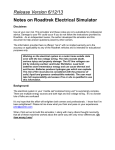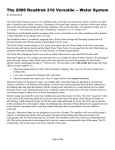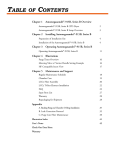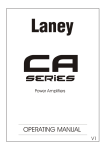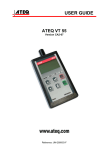Download Release Version 5/30/10 Notes on Roadtrek
Transcript
Release Version 5/30/10 Notes on Roadtrek Electrical Simulator Disclaimer: Use at your own risk. This simulator is not a substitute for professional advice. Damage to your RV could occur if you do not follow the instructions provided by Roadtrek. The information provided here is offered "as is" with no implied warranty as to the accuracy or applicability to any of the Roadtrek vehicles. This simulator is provided as service to members of the Roadtrek owners group "Roadtrek International" and is intended for educational purposes only. Working on the electrical system in a motor home entails risks even with the low voltage wiring. The risks include death, serious injury and property damage. The AC line voltages can kill by inducing cardiac ventricular fibrillation. Lead Acid batteries store tremendous energy and can cause thermal and acid burns. Batteries produce hydrogen gas which can explode. The risk of fire must also be considered with the presence of solid, liquid and gaseous combustible materials. Background: The electrical system in your mobile self contained living unit is a surprisingly complex. There are multiple energy sources and both high and low voltage wiring. It’s no wonder lots of folks are confused! It’s my hope that this effort will enlighten both the normal user and the professional. I know that I’ve been enlightened! Please let me know what you think and pass on your experiences. [email protected] When I first set out to build this simulator I along with many others thought incorrectly that all of these machines worked about the same way with only minor differences. Oh how wrong I was! This version attempts to cover the 4 major configurations which I think covers most of the Roadtrek’s in use today. You might ask; “okay, tell me which configuration do I have?” This question is not so easily answered since not every model in a given year was built in the same way. Additionally mid-model year changes have been made. Don’t despair; there are some simple tests you can run to determine which of the four basic configurations you have. 1 First of all there is the question of do you have a battery isolator or a battery separator. A battery isolator allows the vehicle engine to charge the RV battery but does not allow the RV battery charger to charge the vehicle engine battery. A battery separator makes it possible for the RV battery charger to charge both batteries at the same time. Your user manual lists the components and should indicate if you have an isolator or separator on the “Appliance & Accessory Manufacturer’s Log.” Manuals often have errors, so your vehicle might not match. The best method is to look for the device on your machine and compare it with the pictures. Here is a picture of a typical isolator: On my Chevy 2002, the isolator is bolted to a frame member under the front of the vehicle on the passenger side. I believe in most cases they are located near the engine. The battery separator looks like this: 2 On the Sprinters I’ve looked at, the isolator is attached to the firewall on the driver side of the engine compartment and is clearly visible when you open the hood. I don’t know where it’s located on other vehicles. The next question is how the converter/charger is connected to the electrical system. I’ve looked at the schematics and I know some do not reflect proper configuration. There is an easy test to determine this. With the engine off and the battery disconnect in the off state, you should have no power to the 12 volt RV accessories. Now plug the unit into shore power and notice that your microwave display comes on. If the 12 volt RV lights and accessories can be turned on without touching the battery disconnect switch, you have the direct connection configuration. If they don’t, then you have the bypass configuration. This simulator has a drop down selector and you can directly select one of the four configurations if you know the answers to the above two questions. I’ve also included a number of vehicle years and models which should in theory select the right combination automatically. As of this writing this is woefully inaccurate. I will try to improve this list over time. Simulator Operation: To operate the simulator use the drop down box labeled Model/Year to select your configuration. The first time you use the selector you will get a warning message. The first four options allow you to select based on the above questions. The other options attempt to answer the questions for you based on the model and year. In your vehicle some of the buttons are “momentary” which means that mechanically they don’t stay in the same position when activated. The battery disconnect switch has two momentary positions “ON” and “OFF.” The inverter switch on the other hand is a bistable switch and remains in the position you last left it. The best way to learn how to use the simulator is to push the buttons and see if it behaves as you expect. Be careful, some of this is not intuitive, so you might think there is an error, when it fact it’s working correctly. Of course you may in fact find a bug or two, so please let me know and I will get them fixed. The simulator uses the JavaScript programming language which is built into most browsers and it should work on most computers. It’s possible to run it standalone on your computer. Instructions on how to do this can be found here: http://www.metrotrekkers.org/utility/local.htm 3 Voltage Readings: All of the voltages displayed on the simulator are not absolute and actual conditions will vary greatly. Temperature, battery age, battery type, loads or charging current all impact the result. The readings are intended to give a sense of typical behavior. The simulator does not attempt to model the "surface" charge effect. After charging for a short time, a battery will show a higher voltage which is not representative of the state of charge. To illustrate the drop in apparent battery voltage under load, the simulator displays a slightly lower voltage when the battery disconnect is closed. Again just an indication of the type of changes one would expect and not an absolute value. Simulator Components: The simulator has most of the normal Roadtrek electrical elements and they are interconnected logically so they interact much as they do in the actual environment. Again, this is a "functional" simulator with limited accuracy. Battery Condition Display Roadtrek’s have a monitor panel which has a battery condition function. When you push and hold the test button, the display will show the battery condition as well as the levels for the LP gas, fresh water and holding tanks. The battery condition lights display the current battery voltage which can be representative of the battery condition. The “C” light will be on if the voltage is above about 12.7 volts, the “G” light comes on at about 12 volts, the “F” light comes on at about 11.3 volts. The “L” light will come on with less than 5 volts which really just means the battery has some charge, but does not tell you much more. With an accurate volt meter and allowing the battery to sit without charging or discharging for a time, you can assess the state of charge of a battery. This display does not give that level of detail. With a good fully charged battery and not much load, the “C” will often display even when charging is not taking place. This is particularly true if you have been charging the battery and have recently stopped. The “surface charge” will take some time to dissipate if there is very little load on the battery. I did not attempt to show this behavior on the simulator so it won’t show “C” unless charging is taking place. Note that while charging, the display should always show “C” regardless of the condition of the battery. 4 Just like the actual panel, you have to hold down the button for the display to work. Depending on the configuration it may or may not work with shore power connected and the battery disconnect in the off state. Vehicles with the direct connection will display the converter voltage instead of the battery voltage when connected to AC power with the battery disconnect turned off. Alternator The alternator which is driven by the vehicle engine produces power to charge, not only the normal vehicle battery, but the RV battery. This is a good thing so when one drives to a new location, on arrival RV battery should be fully charged. Note that with isolator equipped vehicles, the alternator connections are NOT the same as a standard vehicle. Modifications have been made and these may seem strange to many technicians who work on automotive electrical systems. The "output" terminal of the alternator will have voltage present and produce current when the engine is running. With the engine and ignition off, the "output" terminal should have no voltage present. The voltage present at the alternator terminal will be noticeably greater than the vehicle battery voltage. This is normal, but again may alarm the technician not familiar with isolator equipped vehicles. Separator equipped vehicles will have changes, but will operate very similar to unmodified vehicles. Vehicle Battery The vehicle battery is a standard automotive type and is used to "start" the vehicle and operate accessories when the engine is not running. This type of battery is not designed to be "deep cycled," but rather is intended to deliver large amounts of current to the starter for a short duration. In isolator equipped vehicles, the battery is connected to the alternator via the isolator which allows both the RV battery and vehicle battery to charge whenever the alternator is active. In separator equipped vehicles, the vehicle battery is connected directly to the alternator and to the RV battery via the separator which connects the batteries together whenever the voltages present on ether battery indicates charging is taking place. Both the separator and isolator perform the most important function that is no matter what mistakes we make in back, the vehicle battery is protected and will start the engine and we can drive home! 5 RV battery The RV battery or batteries are special "deep cycle" types and are designed to be deeply discharged and charged repeatedly. They are not intended to deliver the high current required by the engine starter. The simulator has an RV Battery State dropdown box. You can set the battery state to FULL, POOR or DEAD. Note that if the simulator detects that the battery is "charging" the battery state will automatically change from DEAD to POOR. Deep cycle batteries always have bolt on connections with wing nuts which distinguishes them from common automotive batteries. What type of battery to use is almost a religious discussion and the various types all have some advantages over another. The common flooded electrolyte batteries are the least expensive and if maintained properly will last a long time. Any battery if abused will have a shorter life than one properly maintained and operated. Isolator The isolator has one role and that is to allow the alternator to "charge" the RV battery, but at the same time not allow a light or some other load in the RV to drain the vehicle battery. It does this by allowing current to flow from the A terminal to either the B1 or B2 terminals, but not in reverse. This is done with some high current diodes. So current can flow from the alternator to both batteries, but current cannot flow from the vehicle battery to loads in the RV. The same is true in reverse, should you leave the vehicle headlights on, the RV battery will not get drained. There is another terminal on some isolators. This is needed because many alternators need power to start working. When the ignition switch is "on," 12 volts is present on this terminal. Inside the isolator is a diode connected such that the A terminal will have power. In the normal automotive configuration the alternator output is connected directly to the battery. Note that the alternator voltage is higher than either battery voltage when the engine is running. This is due to the natural voltage drop across the high current diodes. Since the vehicle voltage regulator senses the battery voltage, the regulator calls for slightly more than the normal voltage from the alternator to compensate. The high current diodes will have some voltage drop when current is flowing though the diodes. If the batteries were identical and at an identical state of charge then under 6 charging conditions the voltage at battery terminals B1 and B2 should be very similar. Of course this condition would rarely be the case in practice. A more likely situation is one where one battery is at a much lower state of charge than the other. The voltage at the vehicle battery is used to control the output of the alternator and if the battery is low, then the voltage drop across the diode feeding the vehicle battery will be larger. The user then may see a higher than normal voltage on the RV battery since there will be less voltage drop across that diode due to the lower current. Battery Separator The Separator, like the isolator allows the alternator to "charge" the RV battery, but at the same time not allow a light or some other load in the RV to drain the vehicle battery. It will also allow the converter/charger in the RV to charge the vehicle battery. It does this by monitoring the voltage on both batteries, if either battery voltage is 13.2 volts or higher for more than a few seconds, the separator, connects the batteries together. Should the voltage fall below 13.2 volts for more than a few seconds it will disconnect the batteries. Unlike the isolator, the battery separator is a mechanical switch and there should be little if any voltage drop between the terminals when active. Also with the separator the alternator is connected directly to the battery and the alternator output stud will show voltage even if the vehicle is turned off. Interestingly, the battery separator consumes a significant amount of power when active. The case will become noticeably warm in operation. This is not a problem since when active; you have a source of power other than the batteries. Automatic Resetting Circuit Breakers In the diagram there are three components labeled "CB" with either 50A or 30A labels. These devices are circuit breakers which will open the circuit should there be more than the rated current flow in the circuit. They are thermally operated and after a period of cooling they automatically reset. More recent vehicles have higher current rated circuit breakers. You may wonder why there are two circuit breakers in a series connection. This is because there are power sources at both the front and back of the vehicle. A short circuit will draw current from both sources, so protection near each source provides protection. The batteries, alternator and converter/charger can deliver tremendous current and circuit protection devices are a necessity. 7 The third circuit breaker protects the converter/charger. There are three sources of power driving the same conductor. Again a protection device is needed to remove this source of power should a short circuit arise. Onan Generator The system has a 2.8KW generator which produces 120 volts AC. The generator is directly connected to the RV battery and has a remote control panel to start and stop the unit. If the RV battery has enough charge, it will start the generator regardless of any other conditions in the vehicle. In the simulator the current to the generator starter is shown when the battery has some charge and the start button pushed, but the generator won’t start if the battery condition is poor. When running, the simulator changes the color of the generator from blue to green and a message appears above the block indicating the status. The generator uses the RV battery for starting and control, but does not "charge" the battery directly. Charging occurs due to the operation of the converter/charger using AC power provided by the generator. Depending on the configuration, the battery may or may not change based on the battery disconnect state. Prior to the use of the Tripp-Lite converter/charger the converter charger would not charge the battery very fast. The Tripp-Lite is a much more sophisticated variable rate charger and can charge at a much higher rate. I still contend that running the vehicle engine is the fastest way to charge a depleted RV battery. When I dry camp, running the engine for 30 minutes will make a huge difference in the condition of the RV battery. Note that if the RV battery is extremely low, you may demand more current than the circuit breakers will allow during the initial charging. For the best battery life, one should never discharge the batteries completely. Automatic Transfer Switch The generator is connected to the RV electrical system via an electrically operated switch. When the generator voltage comes up, it will operate this switch, connecting the generator output to the RV systems. Note that when the generator is not running, the RV electrical panel is connected to the shore power cord. This transfer switch is needed to prevent feeding power back into the shore power connector and utility grid. Cord for Shore Power Connection The simulator has provision for the user to indicate if the RV is connected to a source of shore power. When connected, shore power is available to the system. Note that the generator output controls the switch, so even is shore power is available, the generator still carries the load. When connected to shore power the "connection" appears and the wires turn red indicating the presence of voltage. 8 RV 120 Volt AC Fuse Panel and Loads This block represents the RV AC electrical system and also changes green when AC power is available either from the generator or shore power. 120 volt to 12 volt Converter/Charger/Inverter I don’t have this configuration on my machine, but the newer machines do. The older machines only have a converter which converts the 120AC to 12 volts to run the various 12 volt accessories. The newer machines have the Tripp-Lite combination Converter / Inverter / Charger. The Inverter part of the block will produce a limited amount of 120volt power (750watts) using the battery as an energy source. This Inverter is connected to the 120 volt outlets in the galley and the entertainment closet. When external power is available either from the generator or shore power, these outlets are connected directly to that source and are not limited to 750 watts as they are when the Inverter is active. The inverter behavior under low voltage and the presence of shore power is modeled in the simulator. If the battery condition is POOR, the inverter will not operate. When external power is available the inverter is inactive. So with a FULL battery and no external power, the inverter can be turned on. Note that when it’s on, it draws some current form the battery. The inverter has a "load" detection function which can automatically turn the inverter on should a load be present. I’ve not modeled this feature. When connected to external power or a battery with some charge, the low voltage DC wires turn red indicating the presence of DC voltage. If shore power is turned on with the battery disconnected, the Converter will supply power and the low voltage loads will work if you have the direct connection configuration. If you have the direct connection configuration and connect shore power without turning on the battery disconnect first, it may demand more current than the converter can provide when you turn on the battery disconnect. A warning message will appear under this condition. This condition can be avoided by switching the battery "on" before attaching shore power or turning on the generator. Note that the battery disconnect is "powered" from the RV battery and if the battery is dead you cannot operate the switch. Starting the vehicle will charge the battery a bit changing the RV battery state from "DEAD" to "POOR." 9 Battery Disconnect This is a curious device. Unlike a typical relay, it only needs power to open or close. The relay "latches" in the on or off state. The simulator shows the four possible states. The coil can be energized to close the switch, in this case the coil pulls the armature in and a permanent magnet above is "attracted" to the coil, when the power is released the magnet prevents the armature from moving back. To "open" the relay, you reverse the connections to the coil and this deflects the magnet away from the armature. When the coil is de-energized, the armature can move and the circuit is broken. Note that if you "push" and "hold" the rocker switch in the "off" position, the battery disconnect is closed while you hold the switch down. Vehicle Battery Leakage Current In recent years the GM vehicles have much higher battery demand when not in use. This has drastically shortened the time the vehicle can be stored before the vehicle battery runs down. A certain amount of current is required to retain the memory contents of the engine control computer in addition to the normal "self discharge" characteristic of Lead Acid batteries. My 2002 seems to draw about 12 milliamps when idle and can easily be started after 5 or more weeks of inactivity. Anecdotal reports from others who have measured the idle current demand for more recent GM vehicles is about 5 times that amount or about 60 milliamps. The idle time possible has been reduced to about a week. GM seems to think this does not matter since most of these vans are in commercial service and don’t sit idle. Roadtrek addressed the problem of the vehicle battery going dead while parked by replacing the isolator with a battery separator. The isolator allowed the vehicle alternator to charge the RV battery whenever the vehicle was driven, but did not provide for charging the vehicle battery when connected to shore power or running the generator. The battery separator accomplishes this by connecting both batteries together whenever the voltage on either the vehicle battery or the RV battery exceeds about 13 volts indicating that charging is taking place. Oddly enough all is not free, the battery separator typically draws about 10ma while idle increasing the load. It’s not clear from the documentation which battery carries the load, but I suspect it’s probably whichever one has the higher voltage. I’m of the opinion that with the older vehicles the isolator is probably a better choice since it does not add to the leakage problem. 10 Summary: So, in summary there are 4 configurations covered by the simulator: Isolator equipped with converter directly connected to 12 volt loads Separator equipped with converter directly connected to 12 volt loads Isolator equipped with converters which bypass the battery disconnect. Separator equipped with converters which bypass the battery disconnect. This is a "work-in-progress" and there are very likely a few bugs and it may not work correctly. Finally, it is a basic "functional" simulator and does not model real detail. Beyond the states of the various switches and a dead, poor and fully charged battery, it does not understand other conditions. Troubleshooting Tips I’m willing to bet that you are reading this because something does not work the way you expect or it’s clearly broken. Here are a number of situations and the solutions. Remember a set of symptoms is just that a set of symptoms and the actual cause may not be the same as the one described. (I expect to get lots of suggestions for additions to this list.) After stopping for a time with the refrigerator on DC, the vehicle battery has run down. The refrigerator when running on DC requires a lot of current. This mode of operation is really only intended when you are traveling and can’t run it on propane. With a single battery, the refrigerator can run the RV battery down in an hour or less. Assuming the vehicle battery is okay, the isolator or separator is not protecting the vehicle battery from discharge. In the one case I observed, someone had bypassed the isolator effectively connecting both the RV battery and the vehicle battery together. This was probably a temporary fix which was never corrected. Isolators do fail and more often than not fail in the open condition, which prevents one or both batteries from charging. My machine is possessed; the RV lights will be on and suddenly go out only to come back on again. 11 The devices in your machine can demand a lot of current. The wires connecting these devices to the battery have to carry the current. If you have corrosion on the battery terminals this can create a “fuse” or a poor connection which will open under high current turning off the lights. This broken connection will often heal and then the process may repeat erratically. If the battery is low and the inverter charger is on it may behave also behave erratically when this happens. A bad battery can have intermittent internal connections, but this is less common. A poor connection can happen anywhere, but will most likely occur at the battery due to the corrosive conditions at the battery. The lights vary from dim to very bright while running on AC power. The converter may not operate properly unless it’s connected to a battery. I believe the Tripp-Lite can behave this way. If you have the bypass configuration, the converter is always connected to the RV battery and by extension of the separator to the vehicle battery. In one case I saw, the battery connections were bad and the separator was intermittent. This created the no battery connected condition and the converter became unstable. The older converters can shut down due to over current if you plug in first and then switch on the battery in directly connected configurations. This usually happens if the RV battery is very low and demands a lot of current when you make the connection. If the battery is charged, it does not demand much current and you won’t notice a problem. Everything is great until I stop and hook up. After awhile the lights go dim. The only way to get them back is to start the engine. When you are plugged into shore power you should be running off the converter / charger and the battery should be charging. The monitor panel should show “C.” If the converter charger is not operating, you are running off the RV battery even though you are plugged in. First of all make sure you have AC power. I always check the microwave display. If that’s okay then check the AC circuit breakers by cycling them on and off. If that does not solve the problem then the inverter charger is not working and needs to be checked. The mechanic replaced the alternator and the battery and the battery still runs down. In an isolator equipped vehicle the charging current must travel through the isolator. If the isolator is bad the battery won’t charge. The output of the alternator will show a higher than normal voltage because of the voltage drop across the diode in the isolator. This is normal. In addition there may be some additional circuitry unique to an isolator equipped vehicle needed to “start” the alternator. If this circuitry is not working correctly the alternator won’t work. The schematic in the Roadtrek owner’s manual covers these connections. Show this to the mechanic. The vehicle battery runs down in only a week! Is this normal? 12 GM thinks it’s normal. The newer vehicles draw 5 times the previous idle current to keep the accessories alive which limits the standing time to about a week. With a separator equipped vehicle, you can just leave it plugged in and that will solve the problem. Be sure to have the battery switch in the on position if you have the direct connection. If you don’t have a separator, then all you can do is start the vehicle once a week or add a battery charger. You could add a battery switch, but the vehicle will forget all the learned engine settings and it will run poorly until it relearns the proper settings. A real bummer! The RV battery is new, but when I dry camp the battery runs down too fast. Think “green,” if you turn on all the interior lights and run the exhaust fan on full tilt, you will not get as much run time as you will if you conserve. A single group 24M battery is typically 100 amp-hours or less. The Interstate battery website says that you can run for 11.6 hours at a 5 amp load. 5 amps at 12 volts is only 60 watts. That’s not much when you consider the output of a typical 100 watt light bulb. This is of course the reason many rigs have two batteries, but that only doubles the low starting number. Will a solar panel solve my dry camping run-time problem? A solar panel will help, but you will still have to conserve. It takes a big panel to produce a 100 watts and it only produces that level in full sun. If you get 4 hours of full sun that about 0.4 kilowatt-hours. Running your vehicle for 30 minutes can easily produce that much energy. I’d spend my money on LED lights before I added solar panels. It’s interesting that the separator draws power and I suspect if one implemented a solar charger, you would want to keep the separator from activating and using up precious watts! The Battery Warning Light Came on suddenly, while driving Normally this means a bad alternator, broken or slipping fan belt. However in an isolator equipped vehicle, this can also happen when the isolator fails. The alternator output must flow through the isolator and then to the batteries. If the path between the isolator and the vehicle battery no longer functions, you will get this light. Don’t delay getting it fixed, because the alternator may be producing excessive voltage which could be overcharging the coach battery. This can quickly damage the batteries because the electrolyte can literally boil away. I had this happen on a recent trip and when I measured the voltage it was more than 20 volts. This happens because the alternator senses the low vehicle battery voltage and thinks it’s not working hard enough and cranks up the output. 13 A quick temporary fix is to use a heavy jumper and connect the alternator output to the vehicle battery. This requires a hefty jumper, because the current can be more than 100 amps. How do I diagnose the Battery warning Light Problem? (Isolator equipped) As stated earlier, it’s difficult to give hard voltage readings because what you get depends on a lot of factors including the temperature the condition of your batteries and even the engine RPM. Even your voltmeter accuracy comes into play. The surface charge effect can confuse as well. A battery which has just been taken off charge will read a higher than normal voltage until the electrolyte reaches equilibrium. The same is true for a battery which has been discharging at a heavy rate, when your remove the heavy discharge the voltage will be “lower” than normal and return to a value based on its state of charge after a period of time. Don’t jump to conclusions with limited information. The warning light usually indicates that the voltage at the battery is too low and the battery is not charging. The voltage needs to be least 13 volts to charge the battery. It can be low for a number of reasons: 1) 2) 3) 4) 5) 6) 7) 8) Alternator is defective Slipping belt Alternator wiring problem, regulator connection and warning light circuit. The special “starting circuit” for the alternator has failed. (Isolator equipped vehicle.) The connection between the alternator output and the isolator is open. Bad isolator; an open internal diode between the vehicle battery terminal and the alternator terminal or an open diode between the “E” terminal and the alternator output terminal. (Note that this diode is wired such that current can flow from the E terminal to the alternator terminal, but not in reverse.) The connection between the isolator battery terminal and the battery is open. Alternator is “current limited” due to excessive loads or because it’s damaged. If the house batteries are discharged, all of the loads may be more than the alternator can deliver. If the dash battery warning light comes on, I would first measure the voltage at the vehicle battery with the engine running to verify that the voltage is in fact low. If it’s higher than 13 volts, I’m confused since the light would indicate that it should be low, probably 12 volts or less. If it’s low, I would then shut off the engine and then attach a meter wire lead to the alternator output. In the isolator equipped vehicle this is connected to a terminal on the 14 isolator. There is an annotated picture of an isolator on page 2 of this document. If you have a battery separator, then the alternator output is connected directly to the battery. There may be a fusible link in the wiring harness between the alternator output and the battery which could be open. Connect the other meter wire lead to a bare metal part on the frame. This can be a challenge; you can probably find a wire attached to the chassis or connect it to the negative terminal of the battery. I use alligator clips so I don’t have to hold them on. Crawling under a running vehicle to make a measurement is dangerous and not necessary. Start the engine and make the measurement. This alternator output and the battery should be connected by a diode in the isolator and if the alternator is working will be about 1 volt greater than the battery voltage when the engine is running. So if the battery is reading about 13.5 volts I would expect the alternator to read around 14.5 volts. Again the actual voltage can vary, but the difference should be about 1 volt. If the diode has failed “open” it will read much higher. In my case it was about 20 volts with the engine at idle. Measure the house battery voltage at the isolator with the engine running, it should also be about 1 volt less than the alternator output. If it’s much less (Battery voltage more than 1 volt less than the alternator output) then that side of the isolator is bad and it’s not charging the battery. Careful, because if the RV is plugged in and the converter charger is charging the battery it might be the same or more! So perform the test with the RV unplugged and the generator off. Note that the actual voltage drop is a function of how much current is being drawn by each side. With very little current the voltage difference might be only .7 volts but as it goes up the voltage drop will increase, but should not be much more than about 1 volt. So if the house battery is very low, you might see more drop than on the vehicle battery and the reverse would be turn if the vehicle battery was low. The reason the isolator is so large is that this voltage drop creates lots of heat when you have high charging currents. If the alternator output is much lower than the battery voltages, this does not indicate that the isolator is bad. If the alternator output voltage is very low or even 0 with the engine running, it may be that the special starting circuit has failed. There is a “fourth” terminal on the isolator which is connected to the wiring such that it has battery voltage when the ignition switch is in the “Run” position. This delivers battery voltage via a diode in the isolator to the alternator output. This is necessary for the alternator to “start” working. Connect your voltmeter to this fourth terminal and check for battery voltage with the ignition switch in the “run” position with the engine not running. If you don’t have battery voltage here, then you need to trouble shoot this wiring. There may be a relay and a circuit breaker depending on the model. If the voltage is present and there is no voltage present at the alternator output connection on the isolator, then the diode in the isolator is open. 15 Caveats; the wires and connections have resistance, with a lot of current you will see voltage drops between the source of the energy and the load. So if the batteries are really low and you are drawing lots of current, the voltage at the house battery will be less than at the isolator. There are circuit breakers between the isolator and the house battery. In my unit they are rated at 50 amps. Under heavy charging they might open and then the battery voltage would read lower as if the isolator was bad. This is not an isolator problem and they should close after they cool off. If the house battery is really low, you should charge it by plugging into shore power. Don’t condemn the isolator until you are sure you are interpreting the results correctly. With the isolator disconnected you can use an ohmmeter to check the diodes, but the best way is under load on the vehicle. Your ohmmeter may have a “diode” check function depending on the model. If this is the case the normal ohmmeter function may not have enough voltage to switch on the diode and you may think it’s open. Switch the meter leads and you should see it conduct one way and not the other. A-B1 should conduct with A more positive and B1. A-B2 should behave the same way. E-A should conduct when E is more positive than A. B1-B2 should not conduct either way. You can use a battery operated test light to check the diodes as well. Connecting a jumper between the alternator connection and the vehicle battery connection on the isolator essentially returns the vehicle to the typical vehicle configuration and “bypasses” the diodes in the isolator. Now the voltage at the battery and the alternator should be about the same. It’s been reported that with a discharged house battery, the battery light may come on when running the engine. In this case the alternator can’t deliver the high current demanded by all of the loads including the vehicle loads and the batteries. As a result the voltage falls and the light comes on. This is abnormal and the alternator is likely delivering all the current it can. The current follows the voltage, the higher the voltage, the more current the alternator delivers. Effectively it’s “browning out” because it can’t produce the power demanded at the normal voltage. The maximum current is limited by the design of the alternator. Operating the alternator at maximum output is hard on the equipment and can lead to early failure. Under this condition I would expect the alternator output to still be about 1 volt greater than the battery voltage indicating that it is producing power and delivering current to the loads. Not all alternators are created equal and some produce more output than others. You could have an alternator which appears to work, but is damaged and cannot produce full output. Roadtreks are normally equipped with a high output alternators to handle 16 the demands. When a battery is very low, it will demand a lot of charging current, but this usually falls off fairly quickly as the battery charges. Running batteries very low is a recipe for early failure of the batteries and perhaps other components as well. A DC clamp on ammeter is very useful in troubleshooting such problems. Normally to measure current you have to “break” the circuit, but with this type of meter you clamp it around the wire to measure the current. Be sure and get one which measures DC current, since they are less common than AC only clamp on meters which won’t work on DC circuits. Knowing the voltage is only half the story, the current and the voltage will help you understand the situation in much better detail. Isolators are solid state devices and can have variable life spans. They can easily last the life of the vehicle. If they are operated very near their capacity, they will get hot and heat kills electronics. Momentary short circuits can instantly open the diode in an isolator and it becomes an expensive fuse. Closing Comments: I have spent more time on this than I should, but it’s like working a puzzle, its fun, but there are other chores I need to be addressing. I will be happy to add features as time permits and I will fix any bugs promptly if they are brought to my attention. Let me know what you think and if you have any suggestions for improvements. John Slaughter [email protected] 2002 190V Chevy Revisions 5/30/10 Added a discussion about battery warning light and isolator diagnostics. 5/29/10 Updated the Notes 4/30/10 General release after user review. 4/19/10 Fixed a bug where inverter would not discharge RV battery with the switch on and low voltage on one of the configurations. I’m not sure how much current it will draw under this condition, but leaving the inverter switch on will drain the battery on the bypass configuration. Added a note to the screen about voltages to avoid confusion about absolute values. 17 4/18/10 Major revisions to the notes and corrected the simulator to reflect the four configurations described. Added battery monitor panel display function. 4/5/10 Fixed a bug where the converter trace would show red with no voltage. 4/1/10 Changes added to provide for direct connection of converter/charger/inverter to the battery. 3/4/10 Added logic to model the behavior of the Battery Separator equipped vehicles. 3/16/09 Corrected a few minor errors in the notes. 3/15/09 Moved all of the buttons to the left side so users won't miss them if they are using a small screen size. Corrected a bug in the way the inverter switch works. The switch state did not reflect the state table because of the message. Now the state table can only change if the inverter can be turned on. 2/22/09 Fixed the style so the text can be made larger easily. Corrected a problem with the alignment so the simulator will work correctly with FireFox and Safari. 2/21/09 Added "voltage" readouts at various points in the diagram as an indication of possible readings under various conditions. 2/13/08 Clarified battery charging under generator operation. Modified the simulator to display alerts explaining why an action did not have the expected result. Fixed a bug which did not reflect the proper switch status if the user moved the mouse pointer off while holding the button down. 2/4/08 Removed sound effects so application will load faster. Changed the 12 volt on graphic to show the function of the red light on the monitor panel. Made a few changes to clarify the explanations. 18


















